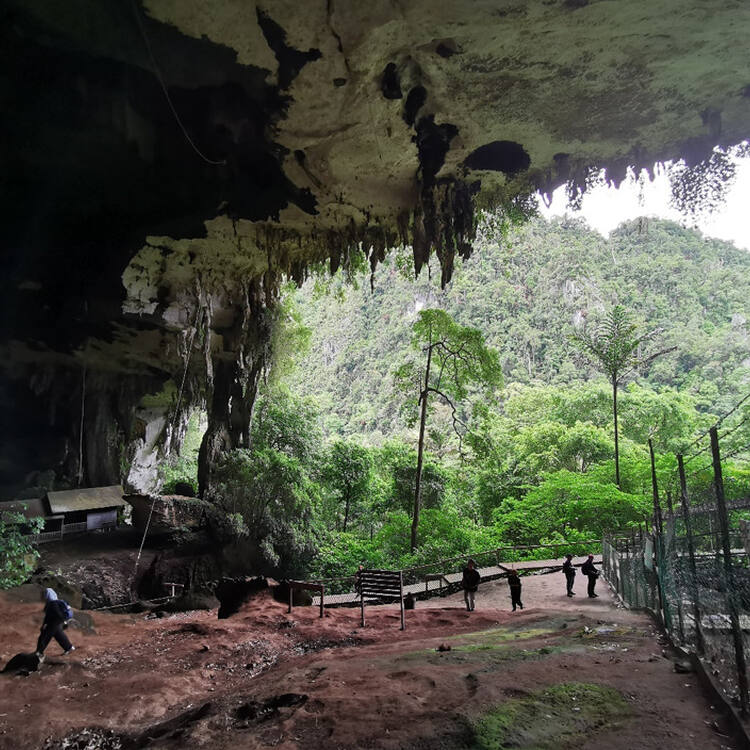The Archaeological Heritage of Niah National Park’s Caves Complex
The Archaeological Heritage of Niah National Park’s Caves Complex
This complex of colossal, interconnected caverns is located near the west coast of Borneo Island at the centre of Niah National Park. It contains the longest known records of human interaction with rainforest, spanning at least 50,000 years, from the Pleistocene to the Mid-Holocene periods. The rich archaeological deposits, prehistoric rock paintings and boat-shaped burials found at the northern edge of the massif illustrate biological and human life during this time, and contribute greatly to the knowledge of human development, adaptation and migration in southeast Asia, as well as in a global context. Local communities still observe an ancient tradition of molong – ‘take only what you need’— when harvesting guano and valuable edible bird’s nests from the caves.Description is available under license CC-BY-SA IGO 3.0
Le patrimoine archéologique de l’ensemble des grottes du parc national de Niah
Ce réseau de cavernes colossales et de nombreuses grottes reliées entre elles est situé près de la côte ouest de l’île de Bornéo, au centre du parc national de Niah. Il contient les plus anciennes traces connues de l’interaction entre les humains et les forêts tropicales, couvrant une période d’au moins 50 000 ans, du Pléistocène à l’Holocène moyen. Les riches gisements archéologiques, les peintures rupestres préhistoriques et les sépultures en forme de bateau retrouvées à l’extrémité nord du massif témoignent de la vie biologique et humaine pendant cette période, et contribuent de manière significative aux connaissances sur le développement, l’adaptation et la dispersion des humains en Asie du Sud-Est et dans le monde. Les populations locales continuent d’observer la tradition séculaire du molong, « ne prends que ce dont tu as besoin », lorsqu’elles récoltent le guano et les nids d’oiseaux comestibles très prisés dans les grottes.
Description is available under license CC-BY-SA IGO 3.0
التراث الأثري لمجمَّع كهوف حديقة نياه الوطنية
يقع هذا المجمَّع الذي يتألف من كهوف ضخمة ومترابطة فيما بينها قرب الساحل الغربي لجزيرة بورنيو في مركز حديقة نياه الوطنية؛ وهو يمتلك أطول فترة معروفة ومسجلة لتفاعل البشر مع الغابة المطيرة، إذ تمتد هذه الفترة طيلة 50000 عام على الأقل من العصر البلستوسيني وصولاً إلى أواسط العصر الهولوسيني. ويتبين وجود حياة بيولوجية وبشرية في تلك الفترة من خلال الرواسب الأثرية الغنية والصخور المرسومة من حقبة ما قبل التاريخ والمدافن التي تأخذ شكل قوارب الموجودة على الطرف الشمالي من الجبل، وتسهم إلى حدٍّ كبير في المعارف المتعلقة بتطور البشر وتأقلمهم وهجرتهم في جنوب شرق آسيا، وكذلك في العالم. ولا يزال المجتمع المحلي يحافظ على تقليد قديم يعرف باسم "مولونغ" أي "خذ ما تحتاج إليه فقط" وذلك عند القيام بجمع ذرق الطائر وأعشاش الطيور القيِّمة الصالحة للأكل من الكهوف.
source: UNESCO/CPE
Description is available under license CC-BY-SA IGO 3.0
尼亚国家公园洞穴考古遗产
该遗产位于婆罗洲岛西海岸附近的尼亚(Niah)国家公园中心,由相互连接的巨型洞穴组成。这里保留了人类在雨林活动的已知最长记录,从更新世到全新世中期,时间跨度至少5万年。山丘北部边缘有丰富的考古遗迹,以及史前岩画和船棺墓葬,展示了这一时期的生物和人类活动,并极大地增进了人们对东南亚乃至全球范围内人类发展、适应、迁徙相关知识的了解。当地居民在洞穴中收集鸟粪和珍贵的食用燕窝时,仍遵奉古老的莫隆(molong)传统,意为“只取所需”。
source: UNESCO/CPE
Description is available under license CC-BY-SA IGO 3.0
尼亚国家公园洞穴考古遗产
该遗产位于婆罗洲岛西海岸附近的尼亚(Niah)国家公园中心,由相互连接的巨型洞穴组成。这里保留了人类在雨林活动的已知最长记录,从更新世到全新世中期,时间跨度至少5万年。山丘北部边缘有丰富的考古遗迹,以及史前岩画和船棺墓葬,展示了这一时期的生物和人类活动,并极大地增进了人们对东南亚乃至全球范围内人类发展、适应、迁徙相关知识的了解。当地居民在洞穴中收集鸟粪和珍贵的食用燕窝时,仍遵奉古老的莫隆(molong)传统,意为“只取所需”。
source: UNESCO/CPE
Description is available under license CC-BY-SA IGO 3.0
Patrimonio arqueológico del conjunto de cuevas del Parque Nacional de Niah
Este complejo de cavernas gigantes e interconectadas se encuentra cerca de la costa occidental de la isla de Borneo, en el centro del Parque Nacional de Niah. Contiene los registros más antiguos conocidos de interacción humana con la selva tropical, abarcando un periodo de al menos 50 000 años, desde el Pleistoceno hasta el Holoceno Medio. Los ricos yacimientos arqueológicos, las pinturas rupestres prehistóricas y las sepulturas en forma de bote halladas en el extremo norte del macizo ilustran la vida biológica y humana durante esta época. Además, todos ellos contribuyen en gran medida al conocimiento del desarrollo humano, la adaptación y la migración en el sudeste asiático, así como en un contexto global. Las comunidades locales siguen observando la antigua tradición del molong –"tomar solo lo que necesitas"– al recoger en las cavernas el guano y los valiosos nidos comestibles de aves.
source: UNESCO/CPE
Description is available under license CC-BY-SA IGO 3.0
Outstanding Universal Value
Brief synthesis
The Archaeological Heritage of Niah National Park’s Caves Complex, located in Niah National Park on the west coast of Borneo Island, is a group of archaeological sites that contain the longest-known records of human interaction with rainforests. Within a complex of colossal interconnected caverns and caves located in a limestone massif, are archaeological sites, rock paintings, and boat-shaped coffins. This rich evidence demonstrates a multifaceted process of human development and adaptation to the physical environment, specifically to the modification of the tropical rainforest from at least 50,000 years ago to the Mid-Holocene, including the transition from foraging to rice farming, arboriculture, and vegeculture. The findings here have contributed significantly to the debate over the nature of the early dispersal of ancient humans across this region and globally.
Criterion (iii): The Niah Caves Complex contains archaeological evidence that represents an exceptional testimony to the cultural traditions of the two disconnected populations in the distant past who existed from the Pleistocene to the Mid-Holocene, exhibiting the rainforest lifestyles, forest management systems (vegeculture), and elaborate funerary practices of prehistoric humans. It contributes significantly to the existing knowledge of human development, adaptation, and dispersal in Southeast Asia and in a global context.
Criterion (v): The Niah Caves Complex is an outstanding example of very early human settlement and land use in the Southeast Asian region, and of human interaction with a changing environment during prehistoric times.
Integrity
The property is of adequate size and contains all the attributes necessary to convey its Outstanding Universal Value, including the entire rock massif and its complex of caves within which the excavated sites, rock paintings, and boat-shaped coffins are located, as well as the sites identified as having archaeological potential. The physical fabric and significant features of the property are in good condition, and the negative factors affecting the property are under control.
Authenticity
The geo-morphological features of the massif and caves have not changed significantly despite the slow dissolution of the limestone over time as a result of natural processes. The excavated sites are well preserved without backfill or other forms of later alteration, testifying to their authentic state at the time of their excavation. Although the locations of the objects extracted from these sites have been changed, these archaeological findings have been appropriately conserved, stored, and displayed in museums. The rock paintings are in their original locations, without any interventions.
Protection and management requirements
The property is state-owned and is legally protected at the national and state levels. At the national level, the property is included in the Bukit Subis Protected Forest that was established under the Forest Ordinance in 1951. Niah National Park was established in 1974 and is protected by the National Parks and Nature Reserves Ordinance and the Wildlife Protection Ordinance of 1998. At the state level, the property is protected by the Sarawak Heritage Ordinance, 2019. The Sarawak Forestry Corporation and the Sarawak Museum Department are the main governmental institutions responsible for implementing the legislative provisions. The buffer zone and a one-kilometre radius zone from the property boundaries provide additional layers of protection.
The management system is a collaborative and coordinated one between the main stakeholders, with the Sarawak Forestry Corporation taking the lead while the Sarawak Museum Department is responsible for the conservation of the cultural heritage. The local communities are involved in the management of the site in a number of ways. The management system is supported and advised by the Special Park Committee for Niah National Park. The management activities are guided by a number of plans, the most comprehensive being the Integrated Conservation Management Plan for the Archaeological Heritage of Niah National Park’s Caves Complex (2024). The key challenges that require long-term attention include securing sustainable funding and the expertise of the staff working on site, the fading of the rock paintings, and the algal growth at the excavated sites.

